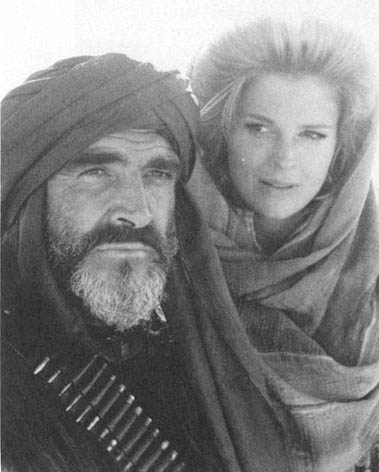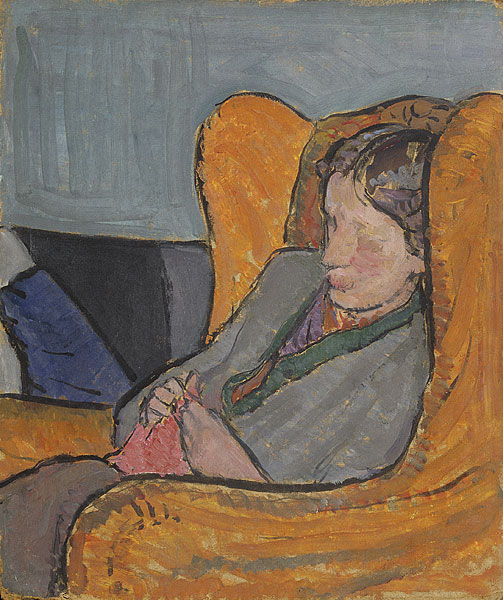 Dust jacket designed and illustrated by Vanessa Bell, 1940-41
Dust jacket designed and illustrated by Vanessa Bell, 1940-41
Virginia Woolf exposed the difficulties of being a woman writer in her essay A Room of One’s Own. Her novels experimented with time and narrative,and she is considered a master of the stream-of-consciousness technique. Woolf battled mental illnesses throughout her life, and eventually committed suicide by drowning herself in 1941, a year before this essay was published. As you read, examine the ways she presents images of life and death.
 The Transformation, by Sulamith Wülfing
The Transformation, by Sulamith Wülfing
“Moths that fly by day are not properly to be called moths; they do not excite that pleasant sense of dark autumn nights and ivy-blossom which the commonest yellow-underwing asleep in the shadow of the curtain never fails to rouse in us. They are hybrid creatures, neither gay like butterflies nor somber like their own species. Nevertheless the present specimen, with his narrow hay-colored wings, fringed with a tassel of the same color, seemed to be content with life. It was a pleasant morning, mid-September, mild, benignant, yet with a keener breath than that of the summer months. The plough was already scoring the field opposite the window, and where the share had been, the earth was pressed flat and gleamed with moisture. Such vigor came rolling in from the fields and the down beyond that it was difficult to keep the eyes strictly turned upon the book. The rooks too were keeping one of their annual festivities; soaring round the tree tops until it looked as if a vast net with thousands of black knots in it had been cast up into the air; which, after a few moments sank slowly down upon the trees until every twig seemed to have a knot at the end of it.
Then, suddenly, the net would be thrown into the air again in a wider circle this time, with the utmost clamor and vociferation, as though to be thrown into the air and settle slowly down upon the tree tops were a tremendously exciting experience. The same energy which inspired the rooks, the ploughmen, the horses, and even, it seemed, the lean bare-backed downs, sent the moth fluttering from side to side of his square of the windowpane. One could not help watching him. One, was, indeed, conscious of a queer feeling of pity for him. The possibilities of pleasure seemed that morning so enormous and so various that to have only a moth’s part in life, and a day moth’s at that, appeared a hard fate, and his zest in enjoying his meager opportunities to the full, pathetic. He flew vigorously to one corner of his compartment, and, after waiting there a second, flew across to the other. What remained for him but to fly to a third corner and then to a fourth? That was all he could do, in spite of the size of the downs, the width of the sky, the far-off smoke of houses, and the romantic voice, now and then, of a steamer out at sea. What he could do he did. Watching him, it seemed as if a fiber, very thin but pure, of the enormous energy of the world had been thrust into his frail and diminutive body. As often as he crossed the pane, I could fancy that a thread of vital light became visible. He was little or nothing but life.
Yet, because he was so small, and so simple a form of the energy that was rolling in at the open window and driving its way through so many narrow and intricate corridors in my own brain and in those of other human beings, there was something marvelous as well as pathetic about him. It was as if someone had taken a tiny bead of pure life and decking it as lightly as possible with down and feathers, had set it dancing and zigzagging to show us the true nature of life. Thus displayed one could not get over the strangeness of it. One is apt to forget all about life, seeing it humped and bossed and garnished and cumbered so that it has to move with the greatest circumspection and dignity. Again, the thought of all that life might have been had he been born in any other shape caused one to view his simple activities with a kind of pity.
After a time, tired by his dancing apparently, he settled on the window ledge in the sun, and, the queer spectacle being at an end, I forgot about him. Then, looking up, my eye was caught by him. He was trying to resume his dancing, but seemed either so stiff or so awkward that he could only flutter to the bottom of the windowpane; and when he tried to fly across it he failed. Being intent on other matters I watched these futile attempts for a time without thinking, unconsciously waiting for him to resume his flight, as one waits for a machine, that has stopped momentarily, to start again without considering the reason of its failure. After perhaps a seventh attempt he slipped from the wooden ledge and fell, fluttering his wings, on to his back on the windowsill. The helplessness of his attitude roused me. It flashed upon me that he was in difficulties; he could no longer raise himself; his legs struggled vainly. But, as I stretched out a pencil, meaning to help him to right himself, it came over me that the failure and awkwardness were the approach of death. I laid the pencil down again.
The legs agitated themselves once more. I looked as if for the enemy against which he struggled. I looked out of doors. What had happened there? Presumably it was midday, and work in the fields had stopped. Stillness and quiet had replaced the previous animation. The birds had taken themselves off to feed in the brooks. The horses stood still. Yet the power was there all the same, massed outside, indifferent, impersonal, not attending to anything in particular. Somehow it was opposed to the little hay-colored moth. It was useless to try to do anything. One could only watch the extraordinary efforts made by those tiny legs against an oncoming doom which could, had it chosen, have submerged an entire city, not merely a city, but masses of human beings; nothing, I knew had any chance against death. Nevertheless after a pause of exhaustion the legs fluttered again. It was superb this last protest, and so frantic that he succeeded at last in righting himself. One’s sympathies, of course, were all on the side of life. Also, when there was nobody to care or to know, this gigantic effort on the part of an insignificant little moth, against a power of such magnitude, to retain what no one else valued or desired to keep, moved one strangely. Again, somehow, one saw life, a pure bead. I lifted the pencil again, useless though I knew it to be. But even as I did so, the unmistakable tokens of death showed themselves. The body relaxed, and instantly grew stiff. The struggle was over. The insignificant little creature now knew death. As I looked at the dead moth, this minute wayside triumph of so great a force over so mean an antagonist filled me with wonder. Just as life had been strange a few minutes before, so death was now as strange. The moth having righted himself now lay most decently and uncomplainingly composed. O yes, he seemed to say, death is stronger than I am.
 Norman Rockwell preparing to enter a mosque
Norman Rockwell preparing to enter a mosque Omar Sharif in Lawrence of Arabia (David Lean, 1962). Sharif’s first English-language role was that of Sharif Ali in David Lean’s historical epic. This performance earned him a Best Supporting Actor Oscar nomination and a Golden Globe Award for Best Supporting Actor – Motion Picture, as well as a shared Golden Globe Award for New Star of the Year – Actor.
Omar Sharif in Lawrence of Arabia (David Lean, 1962). Sharif’s first English-language role was that of Sharif Ali in David Lean’s historical epic. This performance earned him a Best Supporting Actor Oscar nomination and a Golden Globe Award for Best Supporting Actor – Motion Picture, as well as a shared Golden Globe Award for New Star of the Year – Actor. Irish actor Peter O’Toole studying for his role as T.E. Lawrence. Photo by Dennis Oulds
Irish actor Peter O’Toole studying for his role as T.E. Lawrence. Photo by Dennis Oulds Lawrence of Arabia (David Lean, 1962)
Lawrence of Arabia (David Lean, 1962) Robert Pattinson as Lawrence of Arabia in Queen of the Desert (Werner Herzog, 2015), based on the life of British traveller, writer, archaeologist, explorer, cartographer and political officer Gertrude Bell.
Robert Pattinson as Lawrence of Arabia in Queen of the Desert (Werner Herzog, 2015), based on the life of British traveller, writer, archaeologist, explorer, cartographer and political officer Gertrude Bell.
 Candice Bergen and Sean Connery in The Wind and the Lion (John Milius, 1975)
Candice Bergen and Sean Connery in The Wind and the Lion (John Milius, 1975) Virginia Woolf (far left) and her friends, dressed as Abyssinian dignataries, 1910
Virginia Woolf (far left) and her friends, dressed as Abyssinian dignataries, 1910 Truman Capote in Tangier (Morocco)
Truman Capote in Tangier (Morocco) Yves Saint Laurent in Marrakesh
Yves Saint Laurent in Marrakesh
 Christian Louboutin purchased a villa near the Nile river
Christian Louboutin purchased a villa near the Nile river




















